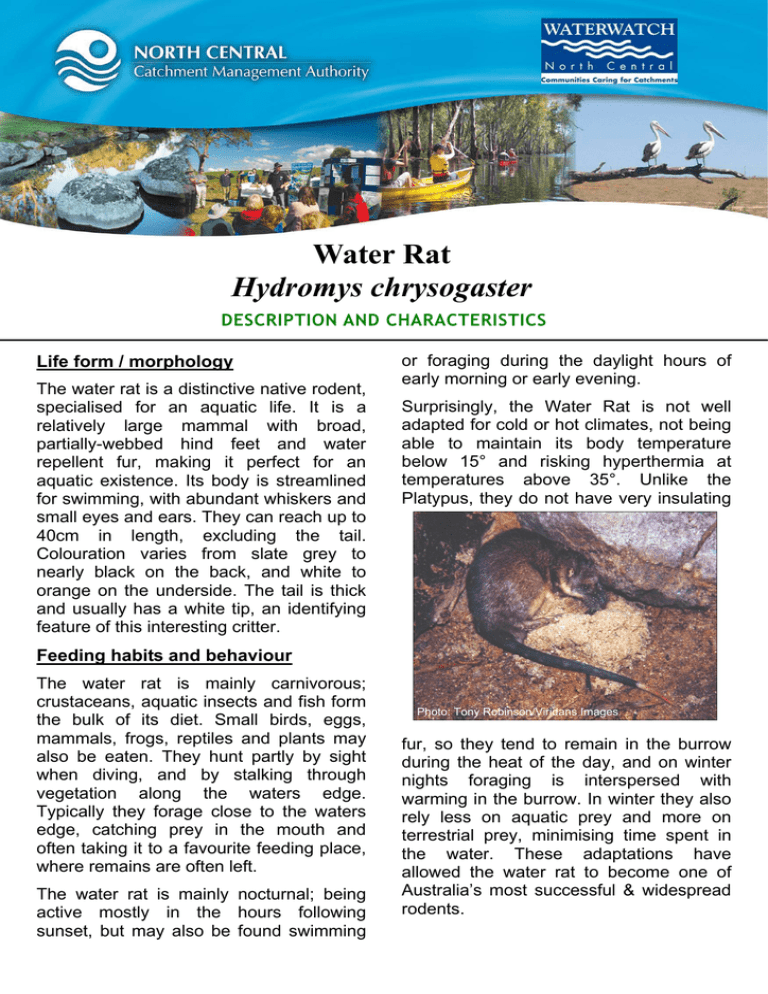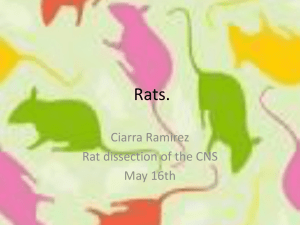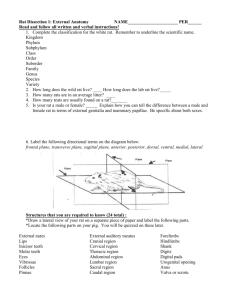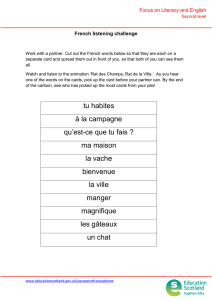Water Rat Hydromys chrysogaster
advertisement

Water Rat Hydromys chrysogaster DESCRIPTION AND CHARACTERISTICS Life form / morphology The water rat is a distinctive native rodent, specialised for an aquatic life. It is a relatively large mammal with broad, partially-webbed hind feet and water repellent fur, making it perfect for an aquatic existence. Its body is streamlined for swimming, with abundant whiskers and small eyes and ears. They can reach up to 40cm in length, excluding the tail. Colouration varies from slate grey to nearly black on the back, and white to orange on the underside. The tail is thick and usually has a white tip, an identifying feature of this interesting critter. or foraging during the daylight hours of early morning or early evening. Surprisingly, the Water Rat is not well adapted for cold or hot climates, not being able to maintain its body temperature below 15° and risking hyperthermia at temperatures above 35°. Unlike the Platypus, they do not have very insulating Feeding habits and behaviour The water rat is mainly carnivorous; crustaceans, aquatic insects and fish form the bulk of its diet. Small birds, eggs, mammals, frogs, reptiles and plants may also be eaten. They hunt partly by sight when diving, and by stalking through vegetation along the waters edge. Typically they forage close to the waters edge, catching prey in the mouth and often taking it to a favourite feeding place, where remains are often left. The water rat is mainly nocturnal; being active mostly in the hours following sunset, but may also be found swimming Photo: Tony Robinson/Viridans Images fur, so they tend to remain in the burrow during the heat of the day, and on winter nights foraging is interspersed with warming in the burrow. In winter they also rely less on aquatic prey and more on terrestrial prey, minimising time spent in the water. These adaptations have allowed the water rat to become one of Australia’s most successful & widespread rodents. LIFE CYCLE AND MATING Water rats mate in late winter and spring. The gestation period is 34 days, with litters born from September to February. Litter size varies from one to seven, with the average litter size being four to five. The female water rat will have one to five litters per breeding season. A nest is constructed in a burrow close to the water, where the young are born and suckled for around four weeks. It is believed that sexual maturity in the wild is not reached until over 12 months of age, and females will breed until 31/2 years old. Water rats are solitary excluding when mating or the female has dependant young. Water rats are territorial and may be aggressive when populations are at a high density. Fighting is common among adults, with both sexes often having bitten or scarred tails. HABITAT AND DISTRIBUTION The water rat is found in Australia, New Guinea and a number of adjacent islands. It is widely distributed in eastern Australia, occurring west to the Kimberley's along the northern coast and west to Eyre Peninsula on the south coast. It is widespread throughout Victoria, found in fresh, brackish and salt water bodies, including shallow lakes, deep water storages, farm dams, slow moving rivers, creeks, estuaries, coastal lakes and sheltered marine bays. They prefer low banks to flat water edges, with many sites having dense vegetation cover on the banks. Photo: Andrew McCutcheon/rakali.com IMPORTANCE AND POTENTIAL THREATS Water rats were not protected by legislation until 1938. Prior to this date, they were widely hunted for their fur, but populations now appear to have recovered. Although water use practises would have surely removed much of its habitat, the water rat is now of least conservation concern and its current range is likely to be similar to those areas occupied prior to European Settlement in Australia. Traditionally, the water rat has been considered to be a pest in the irrigation districts, with belief that its burrows in channel banks and other irrigation structures cause leaking and collapse of structures. Some now regard this damage as less than that caused by freshwater crayfish, whose numbers may well be controlled by the water rat. Predators of the water rat include birds of prey, cats, snakes and large fish (mainly the young are vulnerable). They also appear to have the unusual ability of being able to kill the cane toad without being poisoned. References: Menkhorst, P. W (ed), 1996, Mammals of Victoria: Distribution, Ecology & conservation, Oxford University Press, Melbourne. CSIRO, Water for a Healthy Country, 2004, Taxon Attribute Profiles, Hydromys chrysogaster, available on line at: http://www.anbg.gov.au/cpbr/WfHC/Hydromys-chrysogaster/index.html







